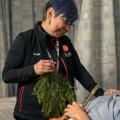Cardiac ablation
A guide for people undergoing cardiac ablation to restore normal heart rhythms.
Overview
Ablation can also be referred to as Cardiac Ablation, Catheter Ablation or Heart Ablation. This procedure can help treat a slower, faster or irregular heartbeat.
It restores the normal regular rhythm by using heat or cold energy. This energy creates tiny scars in the heart. The scars block irregular electrical signals and restore a typical heartbeat. This allows the heart to return to normal, regular rhythm. This procedure is used when medication and other solutions are not working.
Ablation is an option for people who:
- Do not respond to the medications.
- Cannot tolerate the side effects of the medications.
- Continue to have troublesome symptoms even with medication.
Types of ablation
The type of ablation you receive will depend on what type of cardiac arrhythmia you have. Here are some of the common conditions and how ablation works:
Preparing for the procedure
To prepare for this procedure, the doctor may ask you to do one or more tests. Learn more about common cardiac tests & imaging.
- You will need to take your blood thinners as directed by the electrophysiologist. You also may be asked not to eat or drink for several hours before the treatment.
- Please arrange for someone to pick you up and stay with you for at least 24 hours after the procedure. You cannot drive or travel alone for the next 24 hours. You should also refrain from making any important decisions or signing any legal documents during this time.
- We offer interpretation services 24-hours-a-day. Please ask your care team to place a request if you need an interpreter. You can also ask for a sign language interpreter.
- Before the treatment, we'll give you medicine to make you sleepy. You should not feel any pain during the procedure.
During the procedure
- They place an intravenous (or I.V.) in one of your arms to give medicine during the procedure.
- An anesthesiologist gives you medicine so you are sleepy during the procedure. This makes you unable to feel the procedure.
- They attach heart, blood pressure, and oxygen monitors to you. Your skin is prepared. They may shave certain areas to allow heart monitor pads to stick to your skin.
- Your doctor might put a small ultrasound probe down your esophagus. This probe allows the doctor to see the structures of your heart. The doctor can also look for blood clots within your heart during the procedure.
- They will inject numbing medicine to ‘freeze’ the skin at the insertion site, where the catheters enter your body.
- The electrophysiologist inserts the long thin catheters into a large vein in your groin. Sometimes, they insert the catheters in the left shoulder too. The doctor guides the catheters into your heart using an x-ray screen.
- Tiny wires are threaded through the catheters. They locate the tissues causing the abnormal heart rhythm. If needed, they place a catheter through the wall between the right and left side of the heart. This allows them to reach the upper left chamber. The tiny hole heals after the procedure.
- Once in position, the catheters locate the tissues causing the abnormal heart rhythm. Then, the energy destroys these abnormal cells causing the abnormal heartbeat.
After the procedure
- In a recovery area, you're closely monitored as medication wears off and you wake up.
- During this time, you'll rest in bed with your leg kept straight to prevent bleeding from the insertion site. You will feel groggy and possibly feel sick as you wake up. Once you are fully awake, you will have some food and a drink.
- Patients who undergo an ablation procedure usually leave the hospital the same day. but will be monitored until the doctor decides to recover.
- You'll receive further instructions on how to care for yourself once you're home. Please make sure someone picks you up and that you have care for 24 hours after the procedure.
- You may feel some bruising or mild burning sensation. This is common and should go away quickly. Rest and pain medicine like regular Acetaminophen (Tylenol) should help.
If you have questions or concerns:
- Call your heart doctor or family doctor
- Call your Atrial Fibrillation Clinic. The St. Pauls’ Afib Clinic can be reached at 604-806-9475
- Call HealthLink BC at 8-1-1 any time of the day or night to speak to a registered nurse
Support for Indigenous Peoples
The Indigenous Wellness Liaison Team is here to support your health journey. Team members offer cultural support and healthcare advocacy. Learn more below or call them at 604-682-2344,62937 or email IWL@providencehealth.bc.ca.
